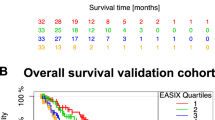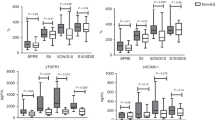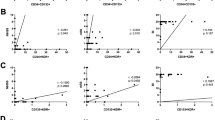Abstract
Endothelial dysfunction has not previously been investigated as a thrombogenic risk factor among patients with acute lymphoblastic leukemia (ALL), known to be at high risk of thromboembolism. We retrospectively explored the association between three circulating biomarkers of endothelial dysfunction (thrombomodulin, syndecan-1, VEGFR-1) measured in prospectively collected blood samples and risk of thromboembolism in 55 cases and 165 time-matched controls, treated according to the NOPHO ALL2008 protocol. In age-, sex-, and risk group-adjusted analysis, increasing levels of thrombomodulin and VEGFR-1 were independently associated with increased odds of developing thromboembolism (OR 1.37 per 1 ng/mL [95% CI 1.20‒1.56, P < 0.0001] and OR 1.21 per 100 pg/mL [95% CI 1.02‒1.21, P = 0.005], respectively). These associations remained significant when including only samples drawn >30 days before thromboembolic diagnosis. Thrombomodulin levels were on average 3.2 ng/mL (95% CI 2.6–8.2 ng/mL) higher in samples with measurable asparaginase activity (P < 0.0001). Among single nucleotide variants located in or neighboring coding genes for the three biomarkers, none were significantly associated with odds of thromboembolism. If results are validated in another cohort, thrombomodulin and VEGFR-1 could serve as predictive biomarkers, identifying patients in need of preemptive antithrombotic prophylaxis.
This is a preview of subscription content, access via your institution
Access options
Subscribe to this journal
Receive 12 print issues and online access
$259.00 per year
only $21.58 per issue
Buy this article
- Purchase on Springer Link
- Instant access to full article PDF
Prices may be subject to local taxes which are calculated during checkout


Similar content being viewed by others
References
Toft N, Birgens H, Abrahamsson J, Griškevičius L, Hallböök H, Heyman M. et al. Results of NOPHO ALL2008 treatment for patients 1-45 years with acute lymphoblastic leukemia. Leukemia. 2017;32:606–15.
Toft N, Birgens H, Abrahamsson J, Griškevičius L, Hallböök H, Heyman M, et al. Toxicity profile and treatment delays in NOPHO ALL2008-comparing adults and children with Philadelphia chromosome-negative acute lymphoblastic leukemia. Eur J Haematol. 2016;96:160–9.
Rank CU, Toft N, Tuckuviene R, Grell K, Nielsen OJ, Frandsen TL. et al. Thromboembolism in acute lymphoblastic leukemia: results of nopho all2008 protocol treatment in patients aged 1 to 45 years. Blood. 2018;131:2475–84.
Athale UH, Chan AKC. Thrombosis in children with acute lymphoblastic leukemia Part I. Epidemiology of thrombosis in children with acute lymphoblastic leukemia. Thromb Res. 2003;111:125–31.
Klok FA, van der Hulle T, den Exter PL, Lankeit M, Huisman MV, Konstantinides S. The post-PE syndrome: a new concept for chronic complications of pulmonary embolism. Blood Rev. 2014;28:221–6.
Kuhle S, Spavor M, Massicotte P, Halton J, Cherrick I, Dix D, et al. Prevalence of post-thrombotic syndrome following asymptomatic thrombosis in survivors of acute lymphoblastic leukemia. J Thromb Haemost. 2008;6:589–94.
Goldenberg NA, Donadini MP, Kahn SR, Crowther M, Kenet G, Nowak-Göttl U. et al. Post-thrombotic syndrome in children: a systematic review of frequency of occurrence, validity of outcome measures, and prognostic factors. Haematologica. 2010;95:1952–9.
Musgrave KM, van Delft FW, Avery PJ, Clack RM, Chalmers EA, Qureshi A, et al. Cerebral sinovenous thrombosis in children and young adults with acute lymphoblastic leukaemia – a cohort study from the United Kingdom. Br J Haematol. 2017;179:667–9.
Hijiya N, Van Der Sluis IM. Asparaginase-Associated toxicity in children with acute lymphoblastic leukemia. Leuk Lymphoma. 2016;57:748–57.
Truelove E, Fielding AK, Hunt BJ. The coagulopathy and thrombotic risk associated with L-Asparaginase treatment in adults with acute lymphoblastic leukaemia. Leukemia. 2013;27:553–9.
Ramsay NKC, Coccia PF, Krivit W, Nesbit ME, Edson JR. The effect of L‐asparaginase on plasma coagulation factors in acute lymphoblastic leukemia. Cancer. 1977;40:1398–401.
Appel IM, Hop WCJ, Van Kessel-Bakvis C, Stigter R, Pieters R. L-Asparaginase and the effect of age on coagulation and fibrinolysis in childhood acute lymphoblastic leukemia. Thromb Haemost. 2008;100:330–7.
Staddon JH, Smock KJ, Schiffman JD, Fluchel MN, Engel ME, Weyrich AS. et al. Pegasparaginase treatment alters thrombin generation by modulating the protein C and S system in acute lymphoblastic leukaemia/lymphoma. Blood Coagul Fibrinolysis. 2015;26:840–3.
van Zaane B, Nur E, Squizzato A, Gerdes VEA, BÜLler HR, Dekkers OM, et al. Systematic review on the effect of glucocorticoid use on procoagulant, anti-coagulant and fibrinolytic factors. J Thromb Haemost. 2010;8:2483–93.
Ozsoylu S. Effect of corticosteroids on coagulation tests. Acta Haematol. 1983;70:70.
Casillas J, Kahn KL, Doose M, Landier W, Bhatia S, Hernandez J. et al. Transitioning childhood cancer survivors to adult-centered healthcare: insights from parents, adolescent, and young adult survivors. Psychooncology. 2010;19:982–90.
Mitchell L, Hoogendoorn H, Giles AR, Vegh P, Andrew M. Increased endogenous thrombin generation in children with acute lymphoblastic leukemia: risk of thrombotic complications in L’Asparaginase- induced antithrombin III deficiency. Blood. 1994;83:386–91.
Klaassen ILM, Lauw MN, Fiocco M, van der Sluis IM, Pieters R, Middeldorp S, et al. Venous thromboembolism in a large cohort of children with acute lymphoblastic leukemia: risk factors and effect on prognosis. Res Pr Thromb Haemost. 2019;3:234–41.
Jarvis KB, LeBlanc M, Tulstrup M, Nielsen RL, Albertsen BK, Gupta R, et al. Candidate single nucleotide polymorphisms and thromboembolism in acute lymphoblastic leukemia – A NOPHO ALL2008 study. Thromb Res. 2019;184:92–8.
Jarvis KB, Nielsen RL, Gupta R, Hede FD, Huttunen P, Jónsson ÓG, et al. Polygenic risk score-analysis of thromboembolism in patients with acute lymphoblastic leukemia. Thromb Res. 2020;196:15–20.
Mateos MK, Tulstrup M, Quinn MCJ, Tuckuviene R, Marshall GM, Gupta R. et al. Genome-wide association meta-analysis of single-nucleotide polymorphisms and symptomatic venous thromboembolism during therapy for acute lymphoblastic leukemia and lymphoma in caucasian children. Cancers. 2020;12:1285.
Athale UH, Mizrahi T, Laverdière C, Nayiager T, Delva YL, Foster G, et al. Impact of baseline clinical and laboratory features on the risk of thrombosis in children with acute lymphoblastic leukemia: a prospective evaluation. Pediatr Blood Cancer. 2018;65:e26938.
Mukai M, Oka T. Mechanism and management of cancer-associated thrombosis. J Cardiol. 2018;72:89–93.
Levy-Mendelovich S, Barg AA, Kenet G. Thrombosis in pediatric patients with leukemia. Thromb Res. 2018;164:S94–7.
Poredos P, Jezovnik MK. Endothelial dysfunction and venous thrombosis. Angiology. 2018;69:564–7.
Bochenek ML, Schäfer K. Role of endothelial cells in acute and chronic thrombosis. Hamostaseologie. 2019;39:128–39.
Shogo T, Shigeru K, Shinichi O, Nobuo A. Plasma thrombomodulin in health and diseases. Blood. 1990;76:2024–9.
Bertrand J, Bollmann M. Soluble syndecans: biomarkers for diseases and therapeutic options. Br J Pharmacol. 2019;176:67–81.
Wu FTH, Stefanini MO, Mac Gabhann F, Kontos CD, Annex BH, Popel AS. A systems biology perspective on sVEGFR1: its biological function, pathogenic role and therapeutic use. J Cell Mol Med. 2010;14:528–52.
Frandsen TL, Heyman M, Abrahamsson J, Vettenranta K, Åsberg A, Vaitkeviciene G. et al. Complying with the European Clinical Trials directive while surviving the administrative pressure - an alternative approach to toxicity registration in a cancer trial. Eur J Cancer. 2014;50:251–9.
Tulstrup M, Moriyama T, Jiang C, Grosjean M, Nersting J, Abrahamsson J. et al. Effects of germline DHFR and FPGS variants on methotrexate metabolism and relapse of leukemia. Blood. 2020;136:1161–8.
Albertsen BK, Grell K, Abrahamsson J, Lund B, Vettenranta K, Jónsson ÓG, et al. Intermittent versus continuous PEG-asparaginase to reduce asparaginase-associated toxicities: A NOPHO ALL2008 randomized study. J Clin Oncol. 2019;37:1638–46.
Højfeldt SG, Wolthers BO, Tulstrup M, Abrahamsson J, Gupta R, Harila-Saari A, et al. Genetic predisposition to PEG-asparaginase hypersensitivity in children treated according to NOPHO ALL2008. Br J Haematol. 2019;184:405–17.
Chang CC, Chow CC, Tellier LCAM, Vattikuti S, Purcell SM, Lee JJ. Second-generation PLINK: rising to the challenge of larger and richer datasets. Gigascience. 2015;4:7.
Pearson JD. Endothelial cell function and thrombosis. Bailliere’s Best Pr Res Clin Haematol. 1994;7:441–52.
Suzuki K, Kusumoto H, Deyashiki Y, Nishioka J, Maruyamal I, Zushi M, et al. Structure and expression of human thrombomodulin, a thrombin receptor on endothelium acting as a cofactor for protein C activation. EMBO J. 1987;6:1891–7.
Luan ZG, Zhang H, Yang PT, Ma XC, Zhang C, Guo RX. HMGB1 activates nuclear factor-κB signaling by RAGE and increases the production of TNF-α in human umbilical vein endothelial cells. Immunobiology. 2010;215:956–62.
Leung LLK, Myles T, Nishimura T, Song JJ, Robinson WH. Regulation of tissue inflammation by thrombin-activatable carboxypeptidase B (or TAFI). Mol Immunol. 2008;45:4080–3.
Joyce DE, Gelbert L, Ciaccia A, DeHoff B, Grinnell BW. Gene expression profile of antithrombotic protein C defines new mechanisms modulating inflammation and apoptosis. J Biol Chem. 2001;276:11199–203.
Gando S, Nakanishi Y, Kameue T, Nanzaki S. Soluble thrombomodulin increases in patients with disseminated intravascular coagulation and in those with multiple organ dysfunction syndrome after trauma: role of neutrophil elastase. J Trauma - Inj Infect Crit Care. 1995;39:660–4.
Ikegami K, Suzuki Y, Yukioka T, Matsuda H, Shimazaki S. Endothelial cell injury, as quantified by the soluble thrombomodulin level, predicts sepsis/multiple organ dysfunction syndrome after blunt trauma. J Trauma - Inj Infect Crit Care. 1998;44:789–95.
Lin SM, Wang YM, Lin HC, Lee KY, Huang CDA, Liu CY, et al. Serum thrombomodulin level relates to the clinical course of disseminated intravascular coagulation, multiorgan dysfunction syndrome, and mortality in patients with sepsis. Crit Care Med. 2008;36:683–9.
Faust SN, Levin M, Harrison OB, Goldin RD, Lockhart MS, Kondaveeti S, et al. Dysfunction of endothelial protein C activation in severe meningococcal sepsis. N. Engl J Med. 2001;345:408–16.
Diebel LN, Diebel ME, Martin JV, Liberati DM. Acute hyperglycemia exacerbates trauma-induced endothelial and glycocalyx injury: an in vitro model. J Trauma Acute Care Surg. 2018;85:960–7.
Boehme MWJ, Deng Y, Raeth U, Bierhaus A, Ziegler R, Stremmel W. et al. Release of thrombomodulin from endothelial cells by concerted action of TNF-α and neutrophils: In vivo and in vitro studies. Immunology. 1996;87:134–13440.
Hatzipantelis ES, Athanassiou-Metaxa M, Gombakis N, Tzimouli V, Taparkou A, Sidi-Fragandrea V, et al. Thrombomodulin and von Willebrand factor: relation to endothelial dysfunction and disease outcome in children with acute lymphoblastic leukemia. Acta Haematol. 2011;125:130–5.
Hagag AAE, Abdel-Lateef AE, Aly R. Prognostic value of plasma levels of thrombomodulin and von Willebrand factor in Egyptian children with acute lymphoblastic leukemia. J Oncol Pharm Pr. 2014;20:356–61.
Öner AF, Gürgey A, Kirazli Ş, Okur H, Tunç B. Changes of hemostatic factors in children with acute lymphoblastic leukemia receiving combined chemotherapy including high dose methylprednisolone and L-asparaginase. Leuk Lymphoma. 1999;33:361–4.
Yue L, Deng X, Yang M, Li X. Elevated B-type natriuretic peptide (BNP) and soluble thrombomodulin (sTM) indicates severity and poor prognosis of sepsis. Ann Palliat Med. 2021;10:5561–7.
Sertoglu E, Omma A, Yucel C, Colak S, Sandıkcı SC, Ozgurtas T. The relationship of serum VEGF and sVEGFR-1 levels with vascular involvement in patients with Behçet’s disease. Scand J Clin Lab Invest. 2018;78:443–9.
Shibuya M. Vascular endothelial growth factor and its receptor system: Physiological functions in angiogenesis and pathological roles in various diseases. J Biochem. 2013;153:13–9.
Ostrowski SR, Sørensen AM, Windeløv NA, Perner A, Welling KL, Wanscher M, et al. High levels of soluble VEGF receptor 1 early after trauma are associated with shock, sympathoadrenal activation, glycocalyx degradation and inflammation in severely injured patients: a prospective study. Scand J Trauma Resusc Emerg Med. 2012;20:1–8.
Greco M, Palumbo C, Sicuro F, Lobreglio G. Soluble Fms-Like Tyrosine Kinase-1 is a marker of endothelial dysfunction during sepsis. J Clin Med Res. 2018;10:700–6.
Wu FTH, Stefanini MO, Mac Gabhann F, Kontos CD, Annex BH, Popel AS. A systems biology perspective on sVEGFR1: its biological function, pathogenic role and therapeutic use. J Cell Mol Med. 2010;14:528–52.
Hu Q, Dey AL, Yang Y, Shen Y, Jilani IB, Estey EH. et al. Soluble vascular endothelial growth factor receptor 1, and not receptor 2, is an independent prognostic factor in acute myeloid leukemia and myelodysplastic syndromes. Cancer. 2004;100:1884–91.
Tang T, Lai H, Huang X, Gu L, Shi H. Application of serum markers in diagnosis and staging of ovarian endometriosis. J Obstet Gynaecol Res. 2021;47:1441–50.
Uchimido R, Schmidt EP, Shapiro NI. The glycocalyx: a novel diagnostic and therapeutic target in sepsis. Crit Care. 2019;23:16.
Reitsma S, Slaaf DW, Vink H, Van Zandvoort MAMJ, Oude Egbrink MGA. The endothelial glycocalyx: composition, functions, and visualization. Pflug Arch Eur J Physiol. 2007;454:345–59.
Nieuwdorp M, Van Haeften TW, Gouverneur MCLG, Mooij HL, Van Lieshout MHP, Levi M. et al. Loss of endothelial glycocalyx during acute hyperglycemia coincides with endothelial dysfunction and coagulation activation in vivo. Diabetes. 2006;55:480–6.
Sharma M, Tyagi S, Tripathi P, Seth T. Syndecan-1 (sCD138) levels in chronic lymphocytic leukemia: clinical and hematological correlations. Blood Res. 2018;53:205–9.
Seidel C, Sundan A, Hjorth M, Turesson I, Dahl IMS, Abildgaard N. et al. Serum syndecan-1: a new independent prognostic marker in multiple myeloma. Blood. 2000;95:388–92.
Alghandour R, Ebrahim MA, Ghazy H, Shamaa S, Emarah Z, Al-Gayyar MM. Evaluation of the diagnostic and prognostic value of syndecan-1 in acute leukemia patients. Cureus. 2020;12:1–10.
Kastritis E, Laina A, Georgiopoulos G, Gavriatopoulou M, Evangelos EP, Fotiou ED. et al. Carfilzomib-induced endothelial dysfunction, recovery of proteasome activity, and prediction of cardiovascular complications: a prospective study. Leukemia. 2021;e-pub ahead of print. Available from: https://doi.org/10.1038/s41375-021-01141-4.
Guy A, Poisson J, James C, James C. Pathogenesis of cardiovascular events in BCR-ABL1-negative myeloproliferative neoplasms. Leukemia. 2021;35:935–55.
Kiseleva RY, Glassman PM, Greineder CF, Hood ED, Shuvaev VV, Muzykantov VR. Targeting therapeutics to endothelium: are we there yet? Drug Deliv Transl Res. 2018;8:883–902.
Rank CU, Lynggaard LS, Als-Nielsen B, Stock W, Toft N, Nielsen OJ, et al. Prophylaxis of thromboembolism during therapy with asparaginase in adults with acute lymphoblastic leukaemia. Cochrane Database Syst Rev. 2020;10:1465–858.
Acknowledgements
The authors thank all patients involved in this study as well as all colleagues contributing to collection of data and conduction of laboratory analyses. We thank Laboratory assistant Jane H. Knudsen, A-research Lab, Department of Paediatrics and Adolescent Medicine, Aarhus University Hospital.
Funding
This study was supported by research grants from the Danish Childhood Cancer Foundation. RLN was supported by an Interreg grant for the Interregional Childhood Oncology Precision Medicine Exploration (iCOPE) project.
Author information
Authors and Affiliations
Contributions
Contributions: LAJ designed the study, collected, analyzed and interpreted data, and wrote and edited the paper: K. Schmiegelow served as principal investigator for the NOPHO ALL2008 protocol, interpreted data, and critically reviewed the paper; PIJ designed the study, interpreted data, and critically reviewed the paper; TLF served as a childhood investigator, collected data, supervised toxicity reporting, and critically reviewed the paper; KG interpreted data, and critically reviewed statistical analyses and the paper; CUR served as an adult investigator, contributed to TE data collection, and critically reviewed the paper; BKA and LS collected ASP data and edited the paper; RT served as principal investigator for the NOPHO ALL2008 TE working group, collected data and edited the paper; RLN performed genetic analyses and edited the paper; KBK, SST, K.Saks, and OGJ served as childhood investigators, collected data, and edited the paper; PQ-P and RS served as adult investigators, collected data, and edited the paper.
Corresponding author
Ethics declarations
Competing interests
K.Schmiegelow has received speaker fee and/or Advisory Board Honoraria from Jazz Pharmaceuticals (2020) and Servier (2020); speaker fee from Amgen (2020) and Medscape (2020); and Educational grant from Servier (2020). All other authors declare no competing financial interests.
Additional information
Publisher’s note Springer Nature remains neutral with regard to jurisdictional claims in published maps and institutional affiliations.
Supplementary information
Rights and permissions
About this article
Cite this article
Andrés-Jensen, L., Grell, K., Rank, C.U. et al. Endothelial dysfunction and thromboembolism in children, adolescents, and young adults with acute lymphoblastic leukemia. Leukemia 36, 361–369 (2022). https://doi.org/10.1038/s41375-021-01383-2
Received:
Revised:
Accepted:
Published:
Issue Date:
DOI: https://doi.org/10.1038/s41375-021-01383-2



